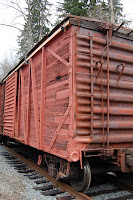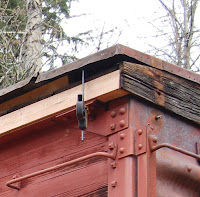 At the Northwest Railway Museum, care for the entire artifact is essential to its long term survival. Many artifacts are 100 years or more of age and have remained outside for that entire time. Water and insects have intruded into many features of the object – in fact into areas that some of the curators may not even know exist. So when an object is being rehabilitated or restored, collection care staff must look at every element to ensure that all threats have been addressed, especially if it involves water, rot or insects.
At the Northwest Railway Museum, care for the entire artifact is essential to its long term survival. Many artifacts are 100 years or more of age and have remained outside for that entire time. Water and insects have intruded into many features of the object – in fact into areas that some of the curators may not even know exist. So when an object is being rehabilitated or restored, collection care staff must look at every element to ensure that all threats have been addressed, especially if it involves water, rot or insects.
 For instance, take the roof of the Northern Pacific Railway boxcar depicted here. The object was built during WW II as a special wartime composite wood and steel car that conserved steel in a time of shortage. In the approximately 70 years since it was built, water has allowed fungus to gradually consume the wood behind the object’s fascia board along the edge of the roof (technically, the “plate” on this car). A more expedient method of addressing the problem may be to replace the fascia and ignore the underlying plate that is normally hidden from view – in essence, focusing on the facade. That approach may seem cost effective in the short term but over years (or even decades) the object and much of its significance will be lost. What significance are we talking about? The techniques and craftsmanship that built the car and that are preserved in the structure – both seen and unseen. It helps us to understand why or how things we take for granted today came to be. That is an important responsibility for a museum because if we don’t do it, who will?
For instance, take the roof of the Northern Pacific Railway boxcar depicted here. The object was built during WW II as a special wartime composite wood and steel car that conserved steel in a time of shortage. In the approximately 70 years since it was built, water has allowed fungus to gradually consume the wood behind the object’s fascia board along the edge of the roof (technically, the “plate” on this car). A more expedient method of addressing the problem may be to replace the fascia and ignore the underlying plate that is normally hidden from view – in essence, focusing on the facade. That approach may seem cost effective in the short term but over years (or even decades) the object and much of its significance will be lost. What significance are we talking about? The techniques and craftsmanship that built the car and that are preserved in the structure – both seen and unseen. It helps us to understand why or how things we take for granted today came to be. That is an important responsibility for a museum because if we don’t do it, who will?

